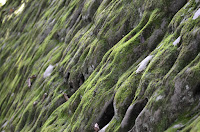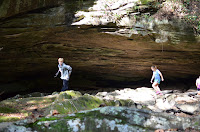Camp Ondessonk :: Sept 30 - Oct 2, 2015
It is with great pride that I introduce our guest bloggers this week ... (drum roll) ... our Grade 6 students! I now turn the blog over to Arushi, Ava, Dillon, Eli, Laura, Lucy, and Ryan!
"I really thought that Outdoor Ed had two parts, night and day time because there were so many great activities that took place in the night and the day. I really enjoyed all the activities, but my favorite activity was rock climbing. I was really excited because it was my first time rock climbing. My classmates were all cheering me on, which made me try harder to get up the rock. I also really enjoyed water zip lining, because it was the first time I’ve been zip lining. I was nervous at first, but when I was done I wanted to go a million more times! I really enjoyed spending time with all my classmates."
- Ava
"The night hike was awesome. We left the campsite and walked up the path to the dining hall. It was so hard to walk up without accidentally without tripping on a rock or getting a tree in the face. When we got to the clearing in front of the dining hall, we played a game called Bat and Moth. It was like Marco Polo, where whoever is the bat is blindfolded, (but whoever is the moth is not) and has to try to get the moth. The bat can find the moth because when the bat says “bat”, the moth says “moth”. After a little bit of that, we resumed our hike. When we took a break, the instructor told us a Native American tale about night vision. Then we went back to the campsite, thinking of how great the night hike was."
- Ryan
"I
personally loved the owl calling experience because we were all together and we were able
to be completely silent so we didn’t scare the owl. When Mr. McClintock pulled
out his speaker we asked him what he was going to do with it, he told us he was
going to bring in a Screech owl. When he played his noise it triangulated from
tree to tree. After a while we heard shaking in the tree sure enough it was the
owl. The owl was in the tree for a long time at a close range. We got
great video footage!"
- Dillon
"Owl calling was not originally a planned activity, but we
did it both nights, and it was a big part of Outdoor Ed. The first night, we
went down to the shower house. Mr. Lancaster, Mr. McClintock, and the boys
finished first, so we went up the hill a little ways and sat at a bench. While
we waited, Mr. McClintock took his phone and a portable speaker. He connected
the speaker to his phone, and he started playing the call of a screech owl.
None of us really believed we could get an owl near us, but every time the call
was played, an owl called back, getting closer and closer.
A few
minutes later, we heard a thump in
the tree above Mr. McClintock! We all turned our flashlights on and shone them
up into the tree. It took a minute, but we finally spotted a small white puff
in the lower branches of the tree – a screech owl! It flew from tree to tree,
finally landing back in our tree and then flying away. The next night, the same
thing happened. It might have even been the same owl! We got some good footage as the owl
triangulated around us."
- Eli
“On the second night of Outdoor Ed we had two people (Foxy and Carrie) from the staff there come to our campsite to teach us how to build a fire. Before they arrived we had to find a good stick for roasting marshmallows, the only reason we did not wait for them is so we could find our stick while it was still light out because Fox and Carrie came when it was dark out. When they arrived they had most of the supplies with them to build the fire. Once we learned how to build a fire and got it started the fun started (not saying building it wasn’t fun). After that we roasted marshmallows, gazed at the stars, learned riddles, and had fun with the cosmic number. As the night went on we got more and more tired so we watched the fire till it died and then we went to bed in our nice and cozy tents.”
- Lucy

"We went zip lining on our second day at outdoor education. Dillon and I went first. There was a huge rock on which the zip line started, and it went down to the end of the lake. We would go down the lake and hit the water, skipping across like a pebble. I was slightly nervous, since this was my very first time, but the fear turned into exhilaration the second I jumped off of the rock. I went zooming at about 50 mph! I screamed going down and hit the water, which felt almost solid at first. Or legs were drenched! We swam to the shore, doing a butterfly stroke. When I came to the shore I realized there was a problem - I LOST MY SHOES!!! My shoes were floating in the water. Thankfully they were coming to the shore. I got the first one with ease, but had to disentangle the second one from a bunch of pond lilies. By the end, I looked like someone who had dove into a muddy puddle! My peach shirt that my mother already thought was dirty, was now covered with stains. My shorts, the same. And my shoes, on the other hand, got a nice bath in the lake! I went another time- with my shoes clipped on the line. I will never forget this experience!"
- Arushi
"Despite the fact that all of the activities were fun, the adventure hike was my favorite. The hike taught me a lot about perseverance, because even though my knee got scraped many times, that only encouraged me to try harder, and climb to the top of the waterfall will all of my friends. I also thought it was cool that all of the rocks we encountered, big and small were created and formed by nature, to create "Nature's playground."
When we first arrived at Camp Ondossonk, we carried our bags to the camp site, and started assembling tents. I learned how to put together the A frame, the tent cover, and the rain coat, and it surprisingly was not as challenging as I thought. On the second day, we made a campfire. Campfire was another one of my favorite activities. We learned how to set up logs and sticks in the correct order, and how to make a fire. I loved the experience."
- Laura




"After lunch, we took a short hike to the porch of the staff room, where we got our harnesses, and then we hiked up to the zip line. We only had four pulleys to attach to the zip line, so Foxy (our guide) showed the way to walk back up to the top quickly so we could pass the pulleys to the next pair. The instructions were to wait for Foxy to give the go-ahead, and then not run, not jump, but WALK of the edge of the cliff. Right as you walk off, you fly over the path to our campsite, and then out over the lake. As the water hurtles towards you, you slowly rotate on the pulley. Then comes the impact.
The water feels solid as you skip across it, but it doesn’t hurt at all. As you slow down, you sink to your waist in the water, and when you are completely stopped, you swim to shore. When you get out of the water, Carrie, our other guide, unbuckles you from the zipline, and you begin the 5-minute walk back up to the start to pass the pulley. We each got to go twice, and many of us thought this was the best activity."
- Eli
"Zip lining was my
favorite activity at Outdoor Ed. The walk there was not as long as the other
hikes. I was in the second group to go. It was awesome! The rope gradually
slopes downward and then you go into the lake. It feels so strange when you
just walk off a cliff on purpose, and then you go down the zip line so fast,
and all this time you are looking at the water, and you know you are going to
hit it, and the wind is pulling your cheeks to the side. And then, you hit the
water. It feels crazy when you skip across it. And then you dunk into it. How
is that, you ask? Wet."
– Ryan
"We were climbing up the rocks, with all our climbing gear,
Slipping sliding falling down, all of that no fear.
We stood up on the ledges, running up the rock,
bumping into boulders, and hurling to the top.
But it really wasn’t easy - cause we fell down several times.
but climbed up all again, using all our strength.
and when we thought we had it, we thought we found success,
we'd go slipping down again!
Then finally we did it giving it all we'd got
giving one big push and jumping to the top!"
- Arushi
"The adventure hike was awesome. On the way to the bouldering place, there were a bunch of big, but not huge, rocks (some were covered with moss) that were great climbing warm-ups. When we got to the place where we would go bouldering, we saw this shallow cave. There was a fossil there that Lucy found. It was a tree! It was great climbing up to the top: not too hard, but definitely not too easy. There was a bunch of small rocks that were prefect for running and jumping on. On the way back, I tried to jump off a rock over a mud puddle, but you guessed it, I fell in the puddle instead. On the way back, we were shown how native Alaskans decided how many large, medium, and small hunting parties, also how many seal holes and seals there were going to be. There were only a few rocks we climbed after the main rocky hills."
-Ryan

"One of my favorite parts of Outdoor Ed. was the Adventure Hike. On the hike we jumped from rock to rock, getting our hands dirty and made our trip more memorable and meaningful. My favorite part of the hike was actually jumping and climbing on the rock, just the feeling under your hands, the fresh air, and the awesomeness of feeling that right now nothing else in the world matters, for me that is the Best feeling ever! I also love when Carrie (part of the staff) took us up to this place up above where we originally were and I guess whenever it rained there was a creek that took the water to part of the rock that stopped and would form a waterfall and the water would flow into the creek down below. Near the end of our hike there were these two rocks that were by each other with a split in the middle big enough for someone to fall into, they were really tall and steep so we decided to climb them. While we climbed we helped and encouraged each other up and down the rock. After the hike I feel like our class now has more trust in each other and that we have now turned out more like a team."
- Lucy












































